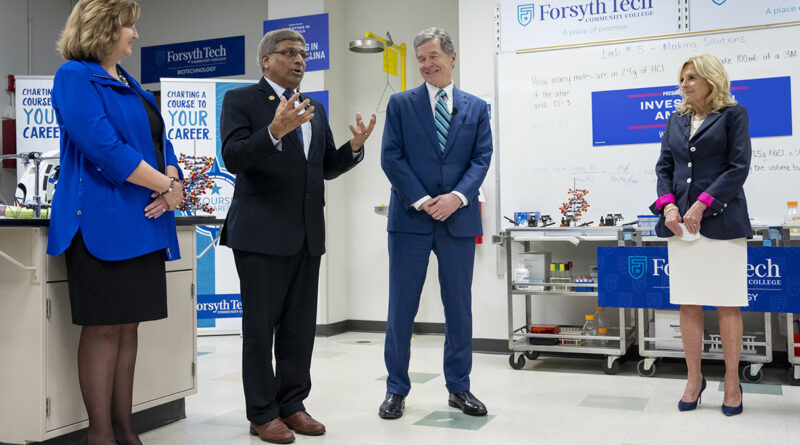In a big bet on science, the U.S. just created 10 new ‘innovation engines’
Molly Hemstreet’s career as an English teacher, community organizer, and entrepreneur in rural western North Carolina doesn’t fit the typical profile of a grantee of the National Science Foundation (NSF). But her vision for reviving North Carolina’s struggling textile industry by using more recycled materials, green manufacturing practices, and a well-trained workforce was tailor-made for a new NSF program designed to fuel economic prosperity in neglected communities across the United States.
Today, NSF announced that Hemstreet’s project is one of the first 10 it is funding under an ambitious and unprecedented program called Regional Innovation Engines (RIEs). If all goes according to plan, each engine will receive up to $160 million over 10 years—by far the largest sum NSF has ever invested in an individual research project and four to five times that awarded to a typical NSF science and technology center.
The engines, says NSF Director Sethuraman Panchanathan, are part of the agency’s “commitment to create opportunity everywhere and enable innovation anywhere.” And Hemstreet says her project, called the North Carolina Textile Innovation and Sustainability Engine, was a good match for NSF’s desire to find “people who can take a research innovation out of the lab… and translate it into jobs and wealth that can flow back into our communities.”
Overall, the 10 engines awarded today—selected from 188 proposals—involve lead institutions from 18 states. They include initiatives to advance regenerative medicine, enhance semiconductor and aerospace manufacturing, develop clean energy production and storage technologies, and address water supply and climate change challenges.
The engines may possess the highest political profile of any NSF program. Panchanathan has made them the flagship of NSF’s new directorate for technology, innovation, and partnerships, created under the CHIPS and Science Act, a 2022 law to bolster the U.S. semiconductor industry. And last week, the White House sent first lady Jill Biden to North Carolina to announce that Hemstreet’s textile project would be one of two led by institutions in the state that narrowly voted for former President Donald Trump in 2020 but that President Joe Biden hopes will help get him reelected this year.
“Today’s investment of $30 million is going to North Carolina to create great jobs,” Jill Biden said at a January 26 visit to Forsyth Technical Community College, which will help conduct the training component of a second North Carolina engine led by Wake Forest University’s Institute for Regenerative Medicine. “And we hope you’ll let the public know what we’re doing here.”
In creating the engines program, Panchanathan promised Congress that it would help address a historical geographic funding imbalance in which just six states receive 40% of the agency’s budget, now $10 billion. A 44-year-old program that steers small amounts of funding to 25 have-not states, called the Established Program to Stimulate Competitive Research (EPSCoR), has done little to change that imbalance. And it appears the first cohort of engines may not make much of a dent.
Only two EPSCoR states—Louisiana and North Dakota—are home to institutions chosen to lead an engine. The Louisiana effort, based at Louisiana State University, will focus on ways to transition its massive oil and gas industry to cleaner alternatives. The North Dakota Engine, led by North Dakota State University, focuses on developing agricultural technologies. Two other EPSCoR states—Nevada and Utah—are home to institutions that have teamed with Arizona State University for a Phoenix-based engine on water security and renewable energy. Groups in Wyoming, another EPSCoR state, will partner with a Fort Collins, Colorado-based consortium that won the award to develop technologies for climate resilience.
For NSF, however, state boundaries were a secondary consideration in judging the potential impact of a proposed engine. That’s because the program, Panchanathan says, is designed to serve communities—wherever they are located—that have not benefited from the massive industrial investments driving today’s digital and high-tech economies.
By that metric, Hemstreet says, the textile industry in North Carolina, which is not an EPSCoR state, certainly qualifies. In 2008, she started a company that has grown into the country’s largest worker-owned apparel manufacturing facility. And in 2015, she formed a nonprofit, called the Industrial Commons, that was awarded the RIE grant.
“I think what appealed to NSF is that we have practical experience bringing people together, developing programs to engage and train young people, and figuring out what the next generation of this industry should look like,” she says. “We also bring a southern rural Appalachian voice to the table.”
Even states with large research institutions have regions that are underserved, notes Anthony Atala, a pediatric urologist and biomedical engineer who directs the Wake Forest Institute, part of a medical school that gets plenty of federal research dollars. “Sure, Winston-Salem is thriving,” he says. “But if you go 20 minutes from the medical school, you see communities that are like ghost towns, where their industries have died and there are no jobs.”
Atala has the CV that you’d expect from an NSF grantee, including membership in the National Academy of Medicine, and has been working for 3 decades on engineering new tissue and organs from extracted cells. But he says his field suffers from a problem that plagues the entire U.S. academic research system and that the Engines program is trying to address.
“We’re very good at innovating in science, but we’re not very good at innovating in manufacturing,” he explains. “So, unless you design and build the right equipment, train the workforce, and develop an efficient distribution system, you could end up with a product that can’t be produced and made available on a mass scale.” Avoiding that outcome, he says, is the goal of the regenerative medicine engine.
Each engine will receive $15 million to rev up in the first 2 years, with the promise of $145 million more over the next 8 years if it meets certain milestones. NSF says its initial investment is being matched by $365 million from private sector partners.
NSF has $200 million in its current budget to launch the first cohort of engines. But it is hoping to get enough money from Congress in annual appropriations to spend billions of dollars on these and subsequent cohorts of engines over the next decade.
The engines “hold significant promise to elevate and transform entire geographic regions,” Panchanathan said at the Forsyth event, which he flew down for from Washington, D.C., with the first lady on Air Force Two. The goal, he added, is to create “world-leading hubs of innovation.”
Source :science.org




